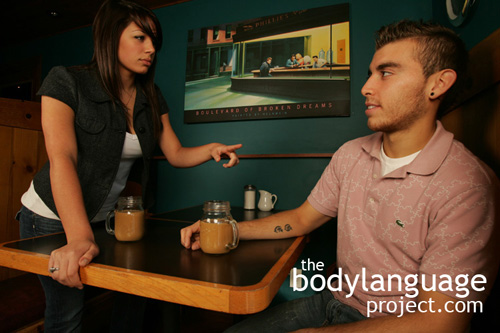Body Language of The Broadside Display or Chest Protrusion.
 Cue: Broadside Display or Chest Protrusion.
Cue: Broadside Display or Chest Protrusion.
Synonym(s): Chest Protrusion, Peacocking, Chest Puffing, Chest Thrust, Chest Arch, Chest Puff, Breast Protrusion, Torso Splay, Puffing Out The Chest, Baring The Torso, Removing A Shirt, Shirt Removal, Protruding The Breast.
Description: A flaring of the torso and chest by bringing air into the lungs to puff out and appear larger. Read more about coding for the expression of pride here: http://bodylanguageproject.com/articles/nonverbal-coding-scheme-pride-shame-objectively-read-pride-shame-body-language/
In One Sentence: Puffing out the chest is a signal that one is dominant and virile and for a part of the universal expression of pride.
How To Use it: Men should use the broadside display to intimidate other men or to express pride. If female, a broadside display can also be used to appear in control and confident, however, the effect will be muddied by the protrusion of breasts which can be seen as sexually inviting. That being the case a confident posture in women can help thwart approaches from lesser quality men whom are not able rise to her level. This can give her the advantage. Overall, this posture should be used with care. It is most useful when one wishes to show that one is proud, healthy, and virile.
Context: a) Dating (male) b) Dating (female) c) Business and General
Verbal Translation: a) and c) “I’m large with a big chest and so I’m dominant and you will submit to me.” “I’m puffing out my chest, see how large I am, you better back down and give me the respect I command.” b) “I am confident, proud of my breasts, youthful with good posture, and therefore I’m a good mate. I want you to notice.”
Variant: See Arms Akimbo, Military Man or Regal Stance, Cowboy Pose Stance.
Cue In Action: a) As he walked by a girl on the beach wearing a skimpy bikini he sucked up his gut, took in a deep breath and arched his shoulders back. b) While waiting for a drink, she leaned back on the bar-top with her elbows, puffed out her chest and looked down submissively as a broadcast signal of her availability. c) The male boxers entered the pre-match weigh-in each with their shoulders held back and chest puffed out. c) A security guard, bouncer or police officer standing guard will perform a broadside display in effort to dissuade an attack. c) We also might see this in business when two conflicting ideas have been presented where each party defends and asserts themselves.
Meaning and/or Motivation: a), b) and c) The intent is to intimidate by appearing larger and therefore more dominant, powerful and also to express pride. It is a high comfort display, opened and bare, inviting challenge and attack that is assumed to never come. a) and b) A sexual or aggressive body language posture depending on the sex.
When done by men, it means dominance regardless of the context as the aim is to impress women and intimidate men. This is meant to appeal to women and repel other aggressive men. In more aggressive contexts, chest puffing is a posture that indicates conflict is nearing and is an advertisement of such. It might seem primitive but chest thumping can find itself during the preamble to a fistfight. Men will sometimes remove a jacket or even a shirt when they prepare for physical confrontation.
When done by women, it is aimed at drawing attention to the breast by making them appear larger and more prominent. Women who puff out their chest are trying to secure the attention of nearby men.
Cue Cluster: Chest protrusion is normally coupled with good upright posture. a) Men will often have a swagger in their step and keep gesturing to a minimum with arms kept around waste level, never much higher. b) Women might subconsciously look down, seemingly at their own breasts as a cue for others to do it as well. In the lowered head position women may gaze upward coyly further strengthening the appeal. c) In a business context, chest puffing will appear with more expansive movements such as greater animation in the arms, encroaching on personal space of others, a loud voice, touching to show ownership, fixed unblinking eye contact and a stern face. Usually the back is also arched and the head is held high.
Body Language Category: Authoritative body language, Courtship display, Confident, Dominant body language, Expansive movements, High confidence body language, Indicators of sexual interest (IOsI), Emotional body language, Threat displays.
Resources:
Allen, Jill; Sarah J. Gervais and Jessi L. Smith. Sit Big to Eat Big: The Interaction of Body Posture and Body Concern on Restrained Eating. Psychology of Women Quarterly 2013. 37(3): 325-336. DOI: 10.1177/0361684313476477pwq.sagepub.com
http://bodylanguageproject.com/articles/sit-big-to-eat-big-how-constrictive-postures-reduce-food-consumption/
Arnette, S. L., & Pettijohn, T. F., II. (2012). The effects of posture on self-perceived leadership. International Journal of Business and Social Science, 3, 8–13.
Beall, Alec and Jessica L. Tracy. The Puzzling Attractiveness of Male Shame. Manuscript submitted to Evolutionary Psychology. www.epjournal.net – 2014. 12(x): 1-39
http://bodylanguageproject.com/articles/male-nonverbal-shame-attractive/?preview=true
Briñol, P., Petty, R. E., & Wagner, B. (2009). Body posture effects on self-evaluation: A self-validation approach. European Journal of Social Psychology, 39, 1053–1064.
Bartholomewn, Morgan E.; Sheri L. Johnson. Nonverbal Dominance Behavior Among Individuals at Risk for Mania. Journal of Affective Disorders. 2014. 159: 133-138.
Barber N. 1995. The evolutionary psychology of physical attractiveness: sexual selection and human morphology. Ethology and Sociobiology 16: 395-424.
Bohns, Vanessa K. and Scott S. Wiltermuth. It Hurts When I Do This (Or You Do That): Posture And Pain tolerance. Journal of Experimental Social Psychology. 2012. 48: 341-345.
http://bodylanguageproject.com/articles/dominant-and-submissive-postures-affects-more-than-public-perception-it-also-affects-felt-pain-and-physical-strength/
Cashdan, Elizabeth. Smiles, Speech, and Body Posture: How Women and Men Display Sociometric Status and Power. Journal of Nonverbal Behavior. 1998. 22(4): 209-228.
Carney, Dana R.; Amy J.C. Cuddy; Andy J. Yap. Power Posing: Brief Nonverbal Displays Affect Neuroendocrine Levels and Risk Tolerance. Psychological Science, 2010; 21 (10): 1363-1368.
http://bodylanguageproject.com/articles/benefits-power-posing-high-stakes-performance/
Carney, Dana R.; Amy J.C. Cuddy; Andy J. Yap. Power Posing: Brief Nonverbal Displays Affect Neuroendocrine Levels and Risk Tolerance. Psychological Science, 2010; 21 (10): 1363-1368.
http://bodylanguageproject.com/articles/benefits-power-posing-high-stakes-performance/
Cesario, J., & McDonald, M. M. (2013). Bodies in context: Power poses as a computation of action possibility. Social Cognition, 31, 260–274.
Cuddy, A. J. C., Wilmuth, C., Yap, A. J., & Carney, D. R. (in press). Preparatory power posing affects nonverbal presence and job interview performance. Journal of Applied Psychology.
Coreen Farris; Teresa A. Treat; Richard J. Viken; and Richard M. McFall. 2008. Perceptual Mechanisms That Characterize Gender Differences in Decoding Women’s Sexual Intent Psychological Science. 2008. 19(4): 348-354.
de Lemus, Soledad; Russell Spears and and Miguel Moya. The Power of a Smile to Move You: Complementary Submissiveness in Women’s Posture as a Function of Gender Salience and Facial Expression. Personality and Social Psychology Bulletin. 2012. 38(11): 1480-1494.
Fischer, Julia; Peter Fischer; Birte Englich; Nilüfer Aydin and Dieter Frey. Empower My Decisions: The Effects of Power Gestures on Confirmatory Information Processing. Journal of Experimental Social Psychology. 2011. 47: 1146-1154.
http://bodylanguageproject.com/articles/downside-power-posing-body-language-looking-power-posing-action-study/
Gorkan Ahmetoglu, Viren Swami. Do Women Prefer “Nice Guys?” The Effect Of Male Dominance Behavior On Women’s Ratings. Social Behavior And Personality, 2012; 40(4), 667-672.
http://bodylanguageproject.com/articles/how-to-significantly-increase-male-attractiveness-with-simple-body-language-nice-guys-finish-last-once-again/
Gangestad, S.W., Thornhill, R., Garver, C., 2002. Changes in women’s sexual interests and their partners’ mate retention tactics across the menstrual cycle: Evidence for shifting conflicts of interest. Proc. R. Soc. London, B 269: 975–982.
Gangestad, S.W., Thornhill, R., Garver-Apgar, C.E., 2005b. Women’s sexual interests across the ovulatory cycle depend on primary partner fluctuating asymmetry. Proc. R. Soc. London, B 272: 2023–2027.
Hasegawa, T. and K. Sakaguchi. 2006. Person perception through gait information and target choice for sexual advances: comparison of likely targets in experiments and real life. Journal of Nonverbal Behavior 30(2): 63-85.
Hall, Jeffrey A. and Chong Xing. The Verbal and Nonverbal Correlates of the Five Flirting Styles. Journal of Nonverbal Behavior. 2015. 39:41–68. DOI 10.1007/s10919-014-0199-8
http://bodylanguageproject.com/articles/first-12-minutes-flirting-using-nonverbal-communication-study-reveals-26-body-language-cues-attraction/
Huang, L., Galinsky, A. D., Gruenfeld, D. H., & Guillory, L. E. (2011). Powerful postures versus powerful roles: Which is the proximate correlate of thought and behavior? Psychological Science, 22, 95–102.
Kelly, Janice R.; Murphy, Julie D.; Craig, Traci Y.; Driscoll, Denise M. 2005. The Effect of Nonverbal Behaviors Associated with Sexual Harassment Proclivity on Women’s Performance Sex Roles: A Journal of Research, 53(9-10): 689-701.
Locke, Connson C. and Cameron Anderson. The Downside of Looking Like a Leader: Leader’s Powerful Demeanor Stifles Follower Voice in Participative Decision-Making.. Academy of Management Annual Meeting Proceedings. 2010. 8(1): 1-6.
http://bodylanguageproject.com/articles/power-body-language-goes-far/
Li Huang, Adam D. Galinsky, Deborah H Gruenfeld and Lucia E. Guillory. Powerful Postures Versus Powerful Roles: Which Is the Proximate Correlate of Thought and Behavior? 2011, Psychological Science; 22(1): 95–102.
http://bodylanguageproject.com/articles/whats-more-powerful-nonverbal-power-or-real-power/
Laird, J. D., & Lacasse, K. (2014). Bodily influences on emotional feelings: Accumulating evidence and extensions of William James’s theory of emotion. Emotion Review, 6, 27–34.
Lee, E. H., & Schnall, S. (2014). The influence of social power on weight perception. Journal of Experimental Psychology: General, 143, 1719–1725.
Martens, Jason P.; Jessica L. Tracy and Azim F. Shariff. Status signals: Adaptive
benefits of displaying and observing the nonverbal expressions of pride and shame, Cognition & Emotion. 2012. 26(3): 390-406. DOI: 10.1080/02699931.2011.645281
http://bodylanguageproject.com/articles/significant-nonverbal-expression-pride-shame-body-language-detailed-examination-origin-function/
Martens, Jason P. Martens and Jessica L. Tracy. The Emotional Origins of a Social Learning Bias: Does the Pride Expression Cue Copying? Social Psychological and Personality Science. 2012; 4(4): 492-499.
http://bodylanguageproject.com/articles/nonverbal-expression-of-pride-elicits-copying-response-from-others/
Michalak, J., Mischnat, J., & Teismann, T. (2014). Sitting posture makes a difference: Embodiment effects on depressive memory bias. Clinical Psychology & Psychotherapy, 21, 519–524.
Minvaleev, R. S., Nozdrachev, A. D., Kir’yanova, V. V., & Ivanov, A. I. (2004). Postural influences on the hormone level in healthy subjects: I. The cobra posture and steroid hormones. Human Physiology, 30, 452–456.
Moore, M. M. and D. L. Butler. 1989. Predictive aspects of nonverbal courtship behavior in women. Semiotica 76(3/4): 205-215.
Moore, M. M. 1985. Nonverbal courtship patterns in women: context and consequences. Ethology and Sociobiology 64: 237-247.
Nelson, Nicole L and James A. Russell. Children’s Understanding Of Nonverbal Expressions Of Pride. Journal of Experimental Child Psychology. 2012; 111: 379-385.
http://bodylanguageproject.com/articles/can-children-read-pride-body-language/
Nair, S., Sagar, M., Sollers, J., III, Consedine, N., & Broadbent, E. (2014). Do slumped and upright postures affect stress responses? A randomized trial. Health Psychology. Advance online publication. doi:10.1037/hea0000146
Navarro, Joe. 2008. What Every BODY is Saying: An Ex-FBI Agent’s Guide to Speed-Reading People. William Morrow Paperbacks.
Oosterwijk, Suzanne; Mark Rotteveel; Agneta H. Fischer and Ursula Hess. Embodied Emotion Concepts: How Generating Words About Pride and Disappointment Influences Posture. European Journal of Social Psychology. 2009. 39: 457–466. DOI: 10.1002/ejsp.584
http://bodylanguageproject.com/articles/embodiment-nonverbal-posture-thinking-pride-shame-literally-changes-body-language/
Park, Lora E.; Lindsey Streamer; Li Huang and Adam D. Galinsky. Stand Tall, But Don’t Put Your Feet Up: Universal and Culturally-Specific Effects of Expansive Postures On Power. Journal of Experimental Social Psychology. 2013; 49: 965–971.
http://bodylanguageproject.com/articles/are-expansive-postures-of-power-universal-or-cultural/
Pillsworth, E. G., M. G. Haselton and D. M. Buss. 2004. Ovulatory shifts in female sexual desire. Journal of Sex Research. 41: 55-65.
Rule, Nicholas, O.; Reginald B. Adams Jr.; Nalini Ambady and Jonathan B. Freeman. Perceptions Of Dominance Following Glimpses Of Faces And Bodies. Perception. 2012; 41: 687-706 doi:10.1068/p7023
http://bodylanguageproject.com/articles/people-can-read-dominance-split-second
Ranehill, Eva; Anna Dreber; Magnus Johannesson; Susanne Leiberg; Sunhae Sul and Roberto A. Weber. Assessing the Robustness of Power Posing: No Effect on Hormones and Risk Tolerance in a Large Sample of Men and Women. Psychological Science, March, 2015. doi: 10.1177/0956797614553946
http://bodylanguageproject.com/articles/power-posing-no-effect-hormones-amy-cuddy-wrong/
Riskind, J. H. (1984). They stoop to conquer: Guiding and selfregulatory functions of physical posture after success and failure. Journal of Personality and Social Psychology, 47, 479–493.
Riskind, J. H., & Gotay, C. C. (1982). Physical posture: Could it have regulatory or feedback effects on motivation and emotion? Motivation and Emotion, 6, 273–298.
Roberts, Tomi-Ann and Yousef Arefi-Afshar. Not All Who Stand Tall Are Proud: Gender Differences in the Proprioceptive Effects of Upright Posture. Cognition and Emtion. 2007. 21(4):714-727.
http://bodylanguageproject.com/articles/do-women-benefit-from-power-posing-study-suggests-not/
Scarpa, Stephano; Alessandra Nart; Erica Gobbi and Atillo Carraro. Does Women’s Attitudinal State Body Image Improve After One Session Of Posture Correction Exercises? Social Behavior and Personality. 2011; 39(8): 1045-1052.
Stanton, Steven J. and Robin S. Edelstein. The Physiology of Women’s Power Motive: Implicit Power Motivation is Positively Associated With Estradiol Levels in Women. Journal of Research in Personality. 2009. 43: 1109-1113.
http://bodylanguageproject.com/articles/the-estrogen-factor-the-search-for-nonverbal-power-in-women/
Stanton, Steven J. The Essential Implications of Gender in Human Behavioral Endocrinology Studies. Frontiers in Behavioral Neuroscience. 2011. 5(9): 1-3. doi: 10.3389/fnbeh.2011.00009
http://bodylanguageproject.com/articles/a-critical-commentary-on-amy-cuddys-power-posing/
Stepper, S., & Strack, F. (1993). Proprioceptive determinants of emotional and nonemotional feelings. Journal of Personality and Social Psychology, 64, 211–220.
Shariff, Azim F. and Jessica L. Tracy. Knowing Who’s Boss: Implicit Perceptions of Status From the Nonverbal Expression of Pride. Emotion. 2009.9(5): 631-639.
http://bodylanguageproject.com/articles/can-you-tell-whos-boss-by-the-nonverbal-expression-of-pride/
Strelan, P., Weick, M., & Vasiljevic, M. (2013). Power and revenge. British Journal of Social Psychology, 53, 521–540.
Tiedens, L. Z., & Fragale, A. R. (2003). Power moves: Complementarity in dominant and submissive nonverbal behavior. Journal of Personality and Social Psychology, 84,
558–568.
Tiedens, Larissa Z. and Alison R. Fragale. Power Moves: Complementarity in Dominant and Submissive Nonverbal Behavior. Journal of Personality and Social Psychology. 2003, 84(3): 558–568.
Tracy, Jessica L. and Richard W. Robins. The Nonverbal Expression of Pride: Evidence for Cross-Cultural Recognition. Journal of Personality and Social Psychology. 2008. 94(3): 516–530. DOI: 10.1037/0022-3514.94.3.516
http://bodylanguageproject.com/articles/nonverbal-expression-pride-recognized-cross-culturally/
Tracy, Jessica L.; Azim F. Shariff; Wanying Zhao and Joseph Henrich. Cross-Cultural Evidence That the Nonverbal Expression of Pride Is An Automatic Status. Journal of Experimental Psychology. 2013; 142 (1): 163-180.
http://bodylanguageproject.com/articles/part-ii-evidence-for-the-universal-expression-of-pride/
Jessica L. Tracy and David Matsumoto. The Spontaneous Expression Of Pride And Shame: Evidence For Biologically Innate Nonverbal Displays. 2008; 105 (33) 11655-11660.
http://bodylanguageproject.com/articles/universal-expressions-of-pride-and-shame/
Williams, L. A., & Desteno, D. Pride: Adaptive Social Emotion Or Seventh Sin? Psychological Science. 2009. 20: 284-288.
http://bodylanguageproject.com/articles/part-ii-evidence-for-the-universal-expression-of-pride/
Weisfeld, Glenn E. and Jody M. Beresford. Erectness of Posture as an Indicator of Dominance or Success in Humans. Motivation and Emotion. 1982. 6(2): 113-130.
http://bodylanguageproject.com/articles/body-language-cues-dominance-submission-children/
Welker, Keith M. ; Oberleitner, David E. ; Cain, Samantha ; Carré, Justin M. Upright and left out: Posture moderates the effects of social exclusion on mood and threats to basic needs. European Journal of Social Psychology. 2013 43(5): 355-361.
Yap, Andy J. Abbie S. Wazlawek, Brian J. Lucas, Amy J. C. Cuddy, Dana R. Carney. The Ergonomics of Dishonesty: The Effect of Incidental Posture on Stealing, Cheating, and Traffic Violations, 24(11); 2281-2289.
http://bodylanguageproject.com/articles/body-posture-physical-environment-determine-feelings-and-behaviour-study/





